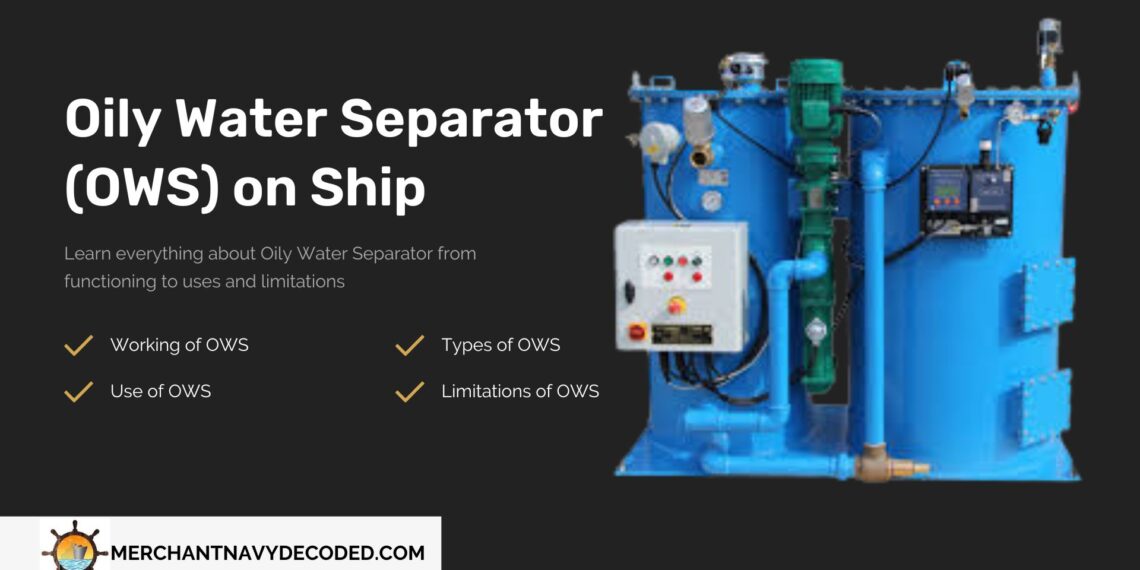Oily Water Separator , Construction, Working, and Principle
Table of contents
1. What is an Oily Water Separator?
An oily water separator is a device used on ships to separate oil from water before discharging it overboard. Its importance lies in environmental protection and regulatory compliance. Ships generate oily water from various sources such as machinery leaks, fuel spills, and cleaning operations. If this oily water is discharged directly into the sea, it can harm marine life and ecosystems.
The oily water separator works by utilizing physical and sometimes chemical processes to separate oil from water. Once the oil is separated, it is either stored for proper disposal onshore or incinerated onboard, depending on regulations and ship capabilities. The clean water is then discharged overboard, typically meeting strict regulatory standards for oil content
2. Oily Water Separator in Ship
Oily water separators on ships are used to efficiently remove oil from bilge water, contribute to the prevention of marine pollution, and guarantee that ships abide by international laws, such as MARPOL Annex I, which places restrictions on the amount of oil that can be discharged into the ocean. Ship operators risk facing severe fines and penalties if they violate these restrictions. Thus, to preserve sustainable shipping operations and safeguard the maritime environment, oily water separators are essential.
3. Oily Water Separator Working Principle

1. Inlet and Pre-Treatment:
The inlet line brings dirty bilge water with fuel, oil, and grease into the OWS. A strainer or coarse filter removes big debris before separation.
2. Separation Tank: In the separation tank, oil is separated from water using centrifugal force, coalescence, or gravity. Gravity makes oil rise to the surface, forming a layer above water. Coalescers help small oil droplets join together to make bigger ones. Centrifugal force pushes heavy particles like oil outward, making it easier to separate them from water in the center.
3. Coalescers and Filters: Coalescers, made from materials that repel water but attract oil, help oil droplets join together in separate tanks. Filters then clean up any remaining solid pollutants or oil droplets from the separated water.
4. Oil Skimmer: An oil skimmer removes the oil layer from the water’s surface after it has been separated. This might be a floating suction device or a mechanical skimmer that gathers oil from the water’s surface.
5. Clean Water Exit: An exit pipe is used to release the cleaned water following separation and oil removal. To guarantee that it complies with regulations, the water may go through further filtration or treatment steps before being released.
6. Pumps and Sensors: Pumps move bilge water through OWS components, while sensors monitor pressure, flow rate, and oil concentration. They provide feedback to the control system for automatic adjustments, ensuring effective operation and legal compliance.
Looking to deepen your understanding of marine engineering? Explore our comprehensive MEO Class 4 course covering oily water separators and maritime environmental regulations.
4. Discharge Regulation for Oily Water Separator
- MARPOL Annex I: MARPOL Annex 1 defines certain rules for ships greater than 400 GT to discharge any oil from the Oily water separator, the first criterion is that the ship should be en route.
- The oil mixture should be processed with an oil filtering machine before passing into the ocean.
- Oil Record Book: All oil-related operations and discharges must be documented in an Oil Record Book (ORB), a requirement for ships covered by MARPOL Annex I. This contains information about how the oily water separator operates, including when it is used, any issues or flaws, and the amount of oily water it processes and releases.
- The oil content in the mixture should not exceed 15 PPM.
- According to MARPOL Annex 1, any oily discharge in the Antarctic region is completely prohibited from any ship.
5. Oily Water Separator Maintenance
- Daily Checks: To make sure there are no obvious leaks, corrosion indicators, or component deterioration, crew members should visually inspect the OWS every day. They should also confirm that every pump, sensor, and valve is operating as it should.
- Routine Inspections: Routine inspections ought to be carried out according to the planned maintenance schedule for the ship or the manufacturer’s instructions. This could entail cleaning and examining coalescers, filters, and other parts in addition to looking for any sediment or sludge accumulation in the separation tank.
- Calibration and Testing: To guarantee reliable results, sensors, and monitoring apparatus should undergo routine calibration and testing. This entails examining the precision of sensors used to regulate the operation of the OWS, such as oil content monitors.
- Oil Skimmer Maintenance: To guarantee correct performance, the oil skimmer on the OWS should undergo routine inspections and cleanings. Replace any worn-out or damaged parts as soon as possible.
- Record Keeping: All OWS-related maintenance activities, including inspections, testing, and any maintenance or repairs performed, should be detailed in the ship’s maintenance records. This makes maintenance tasks more accountable and traceable.
6. Troubleshooting in an OWS
- Excessive oil in discharge can indicate an issue with the OWS operation. Crew members should look for clogged filters, worn-out coalescers, or inappropriate settings.
- Insufficient coalescence or inappropriate operation might cause low efficiency in oil-water separation (OWS). Crew members should ensure that the OWS is operating within the manufacturer’s specifications and inspect the components for any malfunctions or defects.
To troubleshoot sensor malfunctions, crew members should check for loose connections, broken wiring, or fouling of sensor surfaces. Calibration and testing may be required to obtain accurate results. - Inspect pumps for clogs, leaks, or mechanical faults if they stop working properly. Pumps can be kept in good working order by performing regular maintenance and lubrication.
- Identify and address any leaks in the OWS system quickly. Crew members should inspect seals, gaskets, and connectors for damage and replace any worn-out components right away.
7. Types of Oily Water Separators
7.1:- Gravity-Based Oily Water Separators.

- Gravity-based separators use the density difference between oil and water to separate them naturally. They typically consist of a tank or chamber in which the greasy water settles. The less dense oil rises to the surface and is skimmed off, while the water drains from the bottom.
- Separators with baffles or coalescing plates can improve separation by increasing the surface area for oil droplets to rise to the surface.
- Gravity-based separators are often utilized in smaller vessels or facilities with limited space and lower efficiency requirements.
- Advantages include simple design, low cost, and minimum maintenance needs.
- Disadvantages include reduced efficiency in separating tiny oil droplets.
7.2:-Centrifugal Oily Water Separator

- Use centrifugal force to separate oil from water. The oily water is put into a spinning drum or disc, where centrifugal force causes the heavier water to travel outward and the lighter oil to gather in the center before being ejected separately.
- Separators typically have a rotating drum or disk, a pump to feed greasy water and discharge mechanisms.
Centrifugal separators are commonly employed in marine applications due to their excellent efficiency in separating oil from water, even minute droplets. - Advantages include high efficiency, compact construction, and capacity to handle a variety of oily water compositions.
- Disadvantages: High initial investment costs and extensive upkeep owing to moving elements.
7.3:- Membrane Filters:

- Use semi-permeable membranes to separate oil and water. The membranes allow water to travel through while trapping oil and other impurities, yielding highly cleaned water.
- Separators are made up of membranes stacked in modules or cartridges. The oily water is driven through the membranes under pressure, leaving the oil and impurities on the membrane surface.
- Membrane filters are employed for high-purity water in sensitive industrial processes or to meet strict environmental laws.
- The advantages include high effectiveness in eliminating pollutants, compact design, and low oil content in released water.
- The disadvantages include higher initial capital costs and difficult maintenance.
Also, check out the different types of filters on the ship that are used daily onboard.
Conclusion
The role of oily water separators (OWS) in protecting the marine environment and ensuring regulatory compliance is critical. OWS technology is critical to preventing marine pollution because it effectively removes oil and pollutants from bilge water before it is discharged into the sea. Because of these reasons, Oily water separator is one of the most crucial machinery onboard.
Disclaimer :- The opinions expressed in this article belong solely to the author and may not necessarily reflect those of Merchant Navy Decoded. We cannot guarantee the accuracy of the information provided and disclaim any responsibility for it. Data and visuals used are sourced from publicly available information and may not be authenticated by any regulatory body. Reviews and comments appearing on our blogs represent the opinions of individuals and do not necessarily reflect the views of Merchant Navy Decoded. We are not responsible for any loss or damage resulting from reliance on these reviews or comments.
Reproduction, copying, sharing, or use of the article or images in any form is strictly prohibited without prior permission from both the author and Merchant Navy Decoded.



